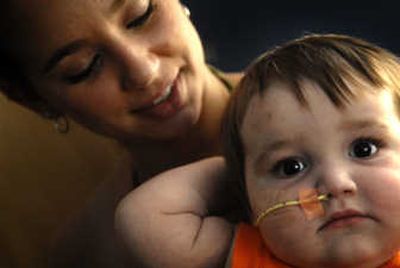Bubble of hope

Caden Atchley is finally back home in Colbert after spending most of his first year in the hospital. But baby-proofing the house for this active, giggly 1-year-old required some serious remodeling.
First, the Atchleys ripped out all of the carpet. They gave away all of the cloth furniture and replaced it with leather. They installed a shower in the garage so Caden’s big brother, Austin, can wash off after kindergarten each day.
Everything that enters the house is sanitized, and a special room has been set up to quarantine anybody who comes down with so much as the sniffles.
All of the efforts are necessary to keep Caden alive. Germs are his big enemy right now.
Caden, who celebrated his first birthday Monday, was born with severe combined immunodeficiency, or SCID – also known as “bubble-boy disease.”
Babies with this genetic disease have no defense against infection. Without treatment, most would die within the first year.
“The hallmark of this is that they’re really born with no functioning T-cells,” says Dr. Troy Torgerson, assistant professor of pediatric immunology at the University of Washington.
“AIDS has gotten a lot of press; that’s caused by a decrease in T-cells,” he says. “You can imagine what happens when you’re missing them completely.”
Caden was sick from his earliest weeks. At first, doctors told his mom, Melissa, that it was just a cold. But then he was diagnosed with pneumonia and, shortly after that, with SCID.
“We didn’t even know what that was,” Melissa Atchley says. “We were just stunned.”
To survive, Caden would need a bone marrow transplant, doctors said.
So Melissa and her husband, Josh, took him to Children’s Hospital in Seattle. (Such transplants aren’t performed in Spokane.) They learned that Caden suffers from a type of the disease called ADA-SCID, in which the body can’t make a particular enzyme responsible for detoxifying cells.
“If you don’t have it, there’s a build-up of these toxic metabolites inside the cells,” Torgerson says. “And it kills them.”
The good news is that ADA-SCID can be treated, at least for a while, with enzyme therapy to boost the immune system.
But that therapy really only buys time until a bone marrow donor can be found. Over time, patients can develop an allergic reaction to the enzyme treatments.
“It makes it so it doesn’t work,” Torgerson says. “Then they’re back to square one. … That’s why bone marrow transplant is the treatment of choice. That has a high chance of actually curing them. This is a total fix.”
The Atchleys are amazed at how people have responded to Caden’s story. Hundreds turned out at bone marrow drives in the area. The family’s Web site has been visited more than 26,000 times and hundreds of people from around the country have signed his online guestbook.
“There’s so much good out there,” Melissa says.
Ironically, kids like Caden, with such minimal immune systems, are perfect candidates for bone marrow transplants. They have few defenses to attack the foreign cells.
After months in the hospital and at the Ronald McDonald House in Seattle, Caden finally got his transplant on April 27.
The bone marrow came from a 19-year-old woman in the United States. For now, that’s all the Atchleys know.
A year after the transplant, the donor gets the option of contacting the recipient’s family. Melissa hopes the donor makes that choice.
“I would just like to thank her and tell her what it truly meant to us,” she says.
Looking at Caden now, with his deep brown eyes, as he pulls up to stand on the coffee table, it’s hard to believe how sick he was.
The days after his transplant were difficult ones. He vomited almost nonstop and had a severe allergic reaction to his medication that required an emergency shot of epinephrine.
“There were some scary times,” Melissa says.
After transplant, graft-vs.-host disease looms as the biggest concern. That’s when donor cells attack the recipient’s body. The disease can range from mild to deadly, and Caden is battling a mild case on his skin and in his intestinal tract.
“He’s still got a little bit going on,” says Dr. Judy Felgenhauer, a pediatric oncologist with Sacred Heart Medical Center who is treating Caden now that he’s back home.
“He looks very good at this point … (but) it’s anybody’s guess if he’s going to have more problems with that.”
Felgenhauer is encouraged by how well Caden seems to be responding to the transplant.
“So far, the numbers I’ve seen look good,” she says. “He’s getting a new immune system.”
SCID patients have been receiving bone marrow transplants for the last several decades, and there are patients who continue to do well, Torgerson says.
“Sometimes these families go away and we don’t hear from them for ages,” he says.
A group of immunologists is pushing for all newborns to be tested for SCID at birth, which increases the odds of successful treatment before a baby is already battling an opportunistic infection.
So far, Wisconsin is the only state with such routine testing, Torgerson says.
Caden faces another year of being a virtual “bubble boy.” Right now, he can only leave the house for doctors’ appointments.
“You take for granted going out and showing your baby off,” Melissa Atchley says.
He can’t be in the sun because of his medications. He can’t dig in the dirt or go swimming.
But his mom hopes that will be different by his next birthday.
“One day he will,” she says. “He won’t remember any of this. I’m always thankful for that.”